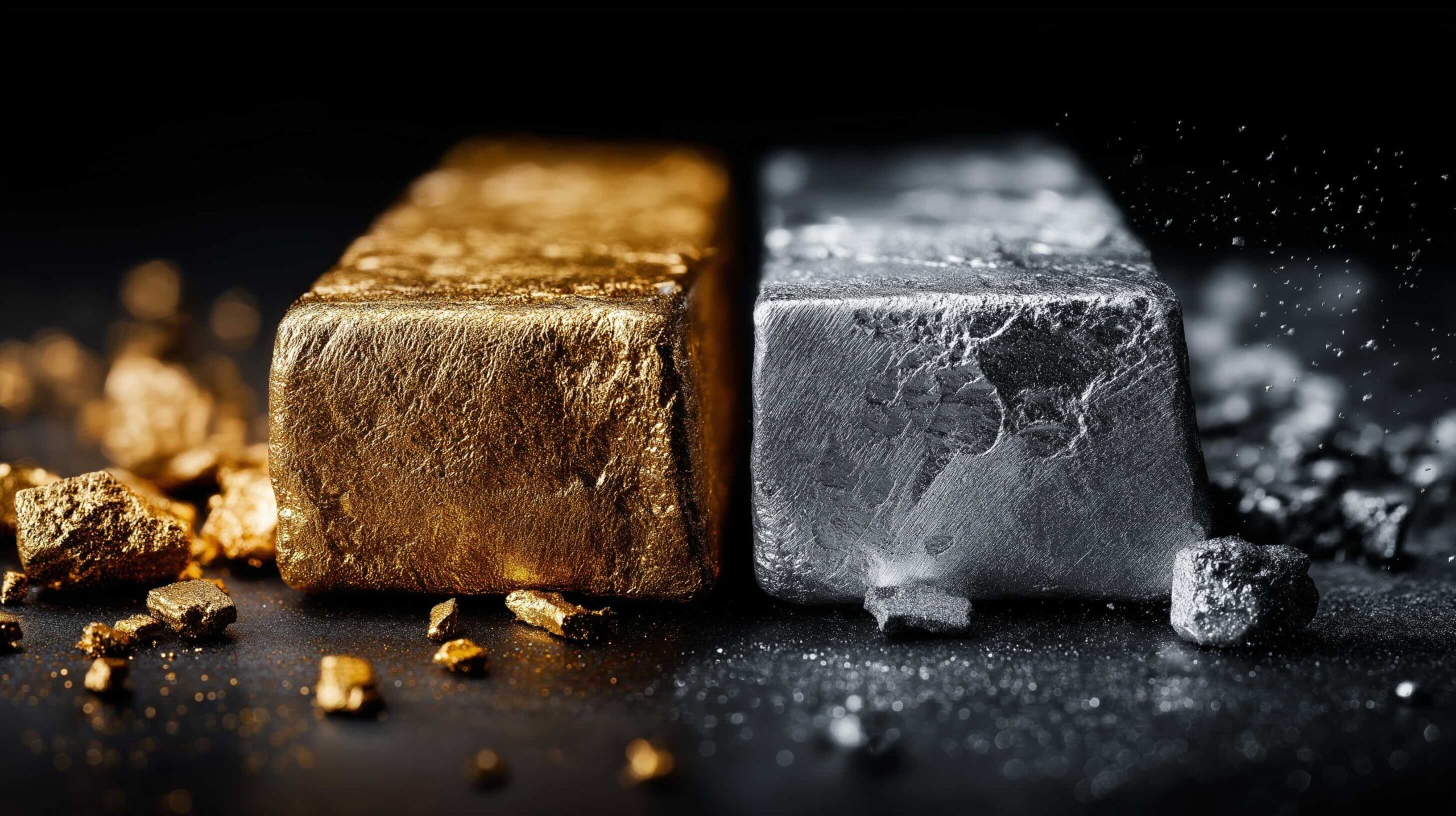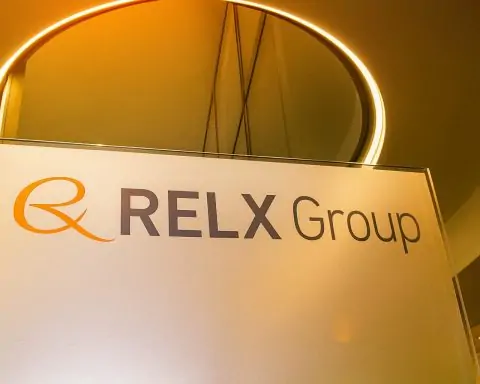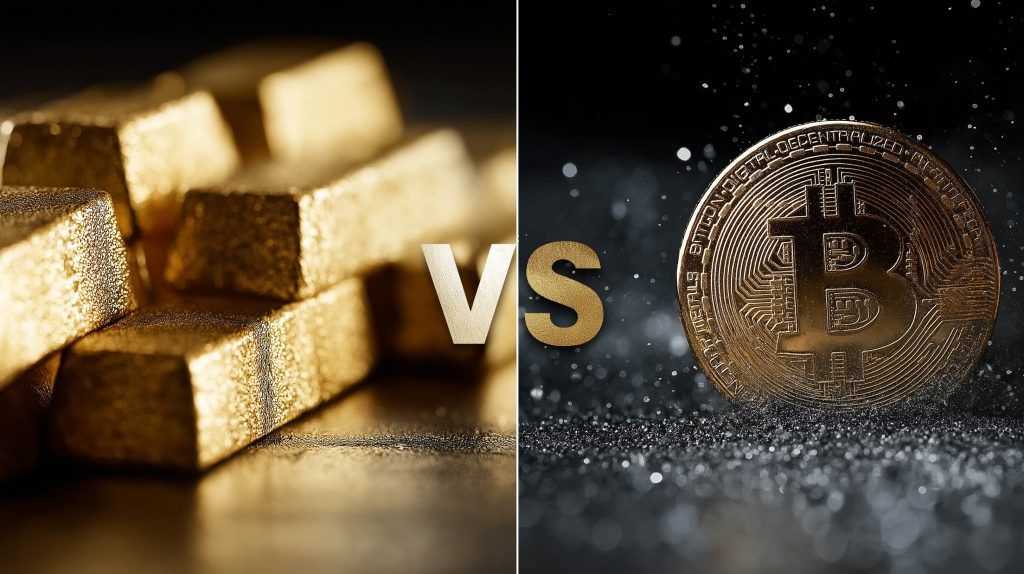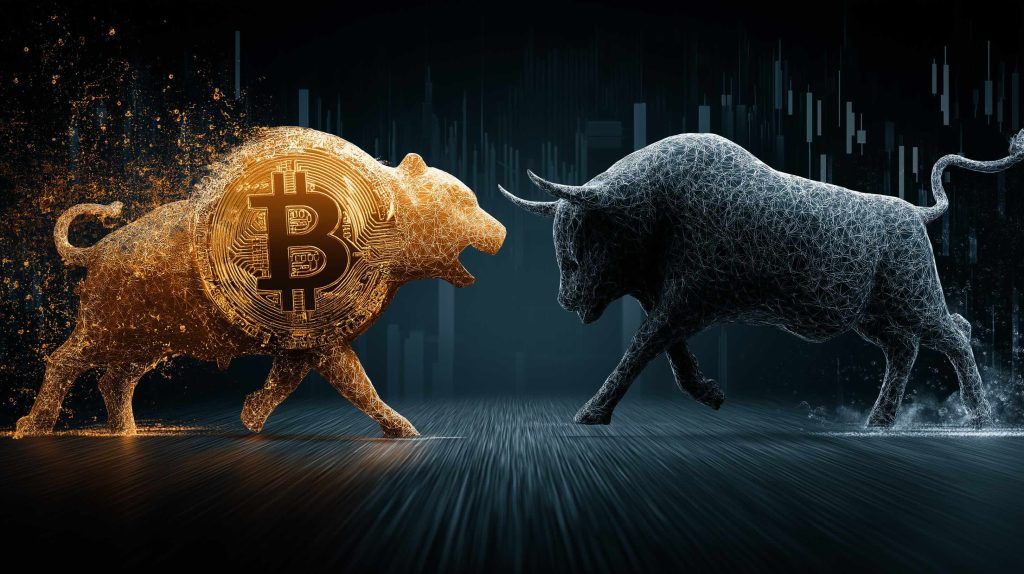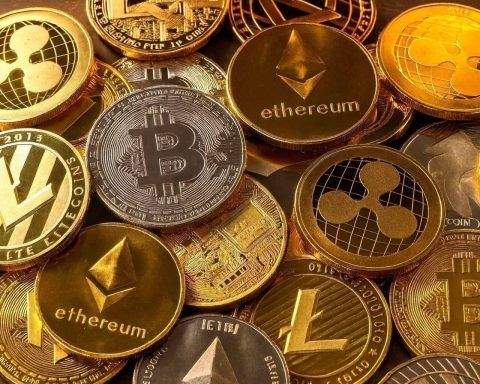- 2025 Price Milestones: Gold soared above $4,000 per ounce for the first time in early October 2025, hitting an intraday high around $4,078 on Oct. 8 [1]. Silver likewise spiked to about $49.5 per ounce (Oct. 8) – its highest level since the 1980 and 2011 peaks – and hovered near the once-mythical $50 mark [2]. As of Oct. 10, 2025, gold trades around $3,950–$4,000/oz and silver around $49/oz, after slight pullbacks from their records [3] [4].
- Spectacular 2025 Gains: Both metals have vastly outperformed stocks this year. Gold is up ~50–53% year-to-date (its best annual run in decades) versus the S&P 500’s ~15% YTD gain [5] [6]. Silver has skyrocketed ~65–70% YTD, even outpacing gold’s rally [7] [8]. In the past month alone, silver jumped ~20%, eclipsing gold’s ~10% rise [9], causing the gold/silver price ratio to tighten to ~82 (down from ~100 earlier in the year) [10].
- Safe-Haven Surge: Investor demand for precious metals has been turbocharged by economic and geopolitical anxieties. Fears of inflation, recession and war, U.S. political turmoil (e.g. a government shutdown), and a weakening dollar have fueled a flight to safety into gold and silver [11] [12]. Notably, a ceasefire in the Middle East in October briefly cooled gold’s rise (prompting profit-taking), but underlying “safe-haven” drivers remain intact [13] [14].
- Central Banks & Investors Pile In: Global central banks are on pace to buy ~1,000 tons of gold in 2025, the fourth consecutive year of massive accumulation [15]. Gold-backed ETFs saw record inflows (over $26 billion in Q3 alone) amid the rush to hedge risk [16]. Silver demand is red-hot as well – silver-backed ETFs added ~95 million ounces in H1 2025 (a record), pushing total holdings above 1.13 billion oz (~$40+ billion worth) [17]. This investor voracity has tightened supply; in fact, 2025 marks silver’s fifth straight supply deficit (projected ~180+ million oz shortfall) [18].
- Industrial Uptick (Silver) vs. Jewelry/Reserve (Gold): About 90% of gold demand comes from investors, central banks, and jewelry, with relatively little industrial use [19]. Silver, by contrast, has heavy industrial demand – over 50% of silver’s usage is in industry/high-tech (solar panels, electronics, etc.) [20]. This industrial boom (especially in solar energy) plus constrained mine output (most silver is a byproduct) have added fundamental support to silver’s price surge [21] [22].
- Short-Term Outlook: Analysts remain largely bullish. UBS expects gold to test $4,200/oz in coming months, and Goldman Sachs projects ~$4,900 by 2026 [23]. HSBC sees silver “on the cusp” of its $50 record, likely to surpass $50/oz imminently, and now forecasts a volatile $45–$53 range through year-end [24]. Some bulls argue a decisive breakout above $50 could even trigger a “generational” spike toward $75 or $100 if a physical squeeze intensifies [25].
- Risks & Volatility: Caution is warranted – neither metal is risk-free. Silver is notoriously volatile, with daily swings often 2–3× larger than gold’s [26]. Historically, dramatic silver spikes (1980, 2011) were followed by brutal crashes [27]. Gold is less volatile but can still fluctuate ±10–15% and may lag when interest rates rise or stability returns [28]. Experts warn against “all-in” bets; while a small allocation can hedge a portfolio, these assets pay no yield and can underperform during strong economic growth [29] [30].
Gold and Silver as Investment Assets
Gold and silver have captivated humankind for millennia – treasured as stores of value, mediums of exchange, and symbols of wealth. Both are classified as precious metals, but they play distinct roles in today’s financial landscape:
- Gold’s Role: Gold is traditionally viewed as the ultimate “safe-haven” asset and a hedge against currency debasement. For centuries, major economies backed currencies with gold (the gold standard), and to this day central banks hold gold bullion as reserve assets. Gold’s value is driven largely by its scarcity, durability, and universal acceptance as a form of wealth. Unlike industrial commodities, gold’s demand comes primarily from jewelry and investment (bars, coins, ETFs) and official sector buying (central banks) [31]. It has relatively few industrial uses, which means gold’s price tends to be influenced by macroeconomic factors (inflation, interest rates, geopolitical risk) more than by business cycle demand. Investors often turn to gold during times of economic turmoil or high inflation, viewing it as a reliable store of value when paper assets falter.
- Silver’s Role: Silver has a dual identity as both a monetary metal and an industrial commodity. Historically, silver was used in coinage (the word “silver” even means “money” in some languages) and was second only to gold as a basis for currency. In modern markets, silver is still a precious metal that investors buy for many of the same reasons as gold (inflation hedge, safe haven, etc.), earning it the nickname “the poor man’s gold” [32]. However, silver is also indispensable in industry – more than half of silver’s demand comes from industrial applications [33]. It is a key component in electronics, solar panels, electrical systems, medical devices, and other technologies. This gives silver a unique economic sensitivity: it can act like a safe haven at times, but its price is also influenced by manufacturing and technology trends. Silver’s cheaper price per ounce and higher abundance (relative to gold) mean it’s often more attainable for small investors – but also that it takes on a more volatile ride, swinging with both investor sentiment and industrial cycles.
In summary, gold is prized chiefly as a financial asset and diversifier – a sort of alternative currency – whereas silver straddles the worlds of investment and industry. Both can provide an inflation hedge and a haven from market stress, but silver’s industrial side adds a growth twist (and extra volatility) that gold lacks.
Performance Over Time: Historical Trends
Figure: Gold (yellow line) vs. Silver (blue line) price trends from 1960–2025. Gold has broadly outpaced silver over the decades, reflected in a rising gold-to-silver price ratio (gold’s price relative to silver). Silver saw explosive spikes around 1980 and 2011, but also long lulls, whereas gold’s ascent has been steadier [34].
Over the long run, both gold and silver have appreciated significantly, but gold’s gains have been more pronounced and consistent. In the late 1960s, gold was fixed at ~$35/oz under the Bretton Woods system; today it’s around $4,000/oz – more than 100× higher. Silver traded around $1–2/oz in the 1960s; now near $50/oz, it’s roughly 25–50× higher (depending on the comparison year).
However, the path for each metal differed markedly:
- Gold’s steadier climb: After the U.S. ended the gold standard in 1971, gold’s price was free to float – and it surged to ~$850/oz by 1980 amid double-digit inflation. It pulled back in the 1980s–90s (hovering a few hundred dollars per ounce), then began a long rally in the 2000s. Gold reached ~$1,900 in 2011 (amid the post-financial crisis and Eurozone turmoil), dipped in the mid-2010s, and then exploded to new highs in 2020 (during the COVID-19 crisis) and again in 2023–2025. Over decades, gold has thus maintained an upward bias, closely tied to currency values and inflation – for example, 2025 is on track to be gold’s best year since 1979 [35] (another period of high inflation). Gold’s ability to hold value over the long term is evidenced by the fact that it has outpaced inflation overall and often sets new highs in times of economic stress.
- Silver’s wild ride: Silver’s historical price story is more volatile and cyclical. It famously spiked to ~$50/oz in January 1980, when the Hunt brothers attempted to corner the silver market – a boom that collapsed spectacularly thereafter. Silver slumped through the 1980s–90s, dropping to ~$5 by the early 2000s. It then rallied with gold in the 2000s commodity boom, nearly reaching $50/oz again in 2011 alongside gold’s peak. Once more, silver plunged back (to ~$14 by 2015) and spent much of the 2010s lagging. It wasn’t until the 2020s that silver revived: a spike to ~$30 in 2020 and now the approach to all-time highs (~$50) in 2025. These dramatic boom-bust cycles mean that while silver’s percentage gains in bull markets can be enormous, it also subjected long-term holders to long periods of stagnation or decline. Indeed, gold has outperformed silver over the past several decades, leading to a much higher gold-to-silver ratio today than historically – as of mid-2025, the ratio was ~74% above its 2000–2015 average, reflecting gold’s stronger long-term growth [36].
Gold-Silver Ratio: This ratio measures how many ounces of silver equal one ounce of gold (price-wise). Historically it has ranged widely – from around 16:1 in the 19th century (when both were currency metals) to over 100:1 at points in recent years. In modern times, a ratio in the 60–80 range has been common. A high ratio means gold is expensive relative to silver (or silver is cheap relative to gold). In 2020, the ratio hit a record ~120:1 during a market panic (gold high, silver low). With silver’s outperformance in 2025, the ratio has fallen from ~100 at the start of the year to roughly 82:1 by October [37]. Some investors watch this ratio to rotate between the metals – e.g. buying silver when it’s historically cheap vs gold, and vice versa – though it’s not a guarantee of future performance.
2025 Record Rally and Current Prices
This year (2025) has been exceptional for precious metals, with both gold and silver staging powerful rallies to record or near-record levels. By early October:
- Gold Breaks $4,000 for the First Time: Gold made headlines worldwide on Oct. 7–8, 2025 by surpassing the $4k/oz milestone – a price never seen before. It peaked at about $4,059/oz on Oct. 8 (a new all-time high) [38]. To put that in perspective, gold entered 2025 around $2,600–2,800, so it has gained roughly $1,300+ in under a year. That ~50% year-to-date jump is extraordinary (for comparison, 1979 saw ~120% and 2020 saw ~25% gains for gold). As of Oct. 10, gold has slightly cooled to the $3,950–$4,000 range [39], after some profit-taking and a rebound in the US dollar. Still, it remains near historic highs, and its YTD performance (around +52%) dwarfs most other asset classes [40].
- Silver Nears the Elusive $50 Mark: Silver’s surge has been even more dramatic in percentage terms. Starting 2025 in the low $30s per ounce, silver climbed relentlessly and in early October it approached its long-standing record high (~$50/oz set in 1980 and briefly matched in 2011). On Oct. 8, spot silver hit ~$49.5/oz intraday – a 14-year high – before settling just under $49 [41]. It then nudged above $50 in intraday trading on Oct. 9, with one report citing a spike up to ~$51.22/oz (a nominal record) before easing back [42] [43]. By Oct. 10, silver is trading around $48–$49/oz [44]. Year-to-date, silver has gained roughly 65–70% [45], making 2025 one of its best years on record. This rally has far outpaced gold’s (~53%) – reversing a trend of silver lagging behind gold in recent years – and has captivated investors who remember silver’s previous run-ups.
- Broader Precious Metals Uptick: Not only gold and silver have shone this year. Other precious metals like platinum have also surged (platinum is up ~80% YTD, hitting ~$1,600/oz – its best level in over a decade [46] [47]), driven by both safe-haven interest and specific supply issues. Mining stocks have likewise benefited: gold miner and silver miner equity indices have roughly doubled in value this year, reflecting leverage to rising metal prices [48]. In short, 2025’s precious metals rally is broad-based, signaling a sweeping investor shift into hard assets.
What makes this 2025 metals boom particularly striking is that it’s occurring alongside strong equity markets. Usually, gold surges when stocks slump, but here both have climbed (the Nasdaq and S&P 500 hit records in 2025, buoyed by tech/AI optimism [49]). This unusual parallel rally suggests that investors are hedging their bets – riding the stock wave but also seeking protection. As one analyst noted, gold’s rise despite stock euphoria hints that “something bad is happening and we should be nervous,” even if surface indicators like equities look upbeat [50] [51]. Indeed, under the market’s hood, there have been plenty of reasons for caution – which leads us to the key drivers behind gold and silver’s ascent.
Why Are Gold and Silver Soaring? Key Drivers in 2025
Multiple forces have converged in 2025 to create a “perfect storm” for precious metals. Here are the major geopolitical and economic drivers boosting gold and silver prices:
Safe-Haven Demand & Geopolitical Turmoil
When uncertainty rises, so does the appeal of gold and silver. This year has seen no shortage of turmoil:
- Geopolitical Conflicts: Ongoing wars and regional conflicts have unnerved investors. Notably, a sharp flare-up in the Middle East (between Israel and Hamas) earlier in the year drove a rush into safe havens. In fact, gold’s jump above $4k in early October was partly attributed to escalating war fears, and it pared back slightly only after a ceasefire agreement was reached on Oct. 9 (easing immediate concerns) [52] [53]. Such events remind markets that geopolitical risk – from wars to international disputes – can spike demand for portable, universally accepted wealth assets.
- Political & Economic Uncertainty: In the U.S., a looming government shutdown and policy gridlock in Washington created anxiety. By October 2025, the federal government had faced funding showdowns, raising fears of halted services and broader economic drag [54]. Additionally, policy turbulence (shifts in regulations, trade policy, etc.) has made the environment unpredictable. Precious metals thrive on this kind of uncertainty. Investors often buy gold as “portfolio insurance” against worst-case scenarios – high debt, fiscal crises, or governance breakdowns [55].
- Market Froth & Tail Risks: Even as stock markets hit highs, there’s an undercurrent of caution about potential “black swan” events. The simultaneous boom in risk assets and safe havens suggests some investors are hedging against a reversal. In 2025, talk of asset bubbles (in tech stocks, for example) and concerns about global debt levels have added to gold’s allure as a hedge. With global sovereign debt at record highs (exacerbated by pandemic spending and stimulus), some fear currency debasement or a debt crisis, leading them to diversify into precious metals [56] [57].
In summary, a backdrop of wars, political strife, and financial system worries has created classic safe-haven demand. Gold in particular is seen as a refuge in “risk-off” moments – and 2025 has provided plenty, from battles in the Middle East to fiscal fights in the US and beyond. Silver, while a more speculative haven, has ridden on gold’s coattails during these episodes [58].
Inflation, Interest Rates & Monetary Policy
Macro-economic factors around inflation and interest rates have been crucial to the metals rally:
- Inflation and Stagflation Fears: The world has been grappling with elevated inflation since 2021–2022. By 2025, inflation in many countries is cooling but remains above central bank targets. Moreover, growth has been uneven, raising whispers of “stagflation” (low growth + high inflation). Precious metals are traditional inflation hedges – when the cost of living rises, gold and silver often gain appeal as stores of real value. The World Gold Council noted that the current mix of rising prices with slowing economic activity is eerily reminiscent of late 1970s stagflation, a scenario that historically benefits gold [59]. Even the expectation of future inflation can drive investors into gold/silver as preemptive protection.
- Federal Reserve Rate Cuts: Perhaps the biggest catalyst in 2025 has been a major shift in monetary policy. After aggressive interest rate hikes in 2022–2024, the U.S. Federal Reserve reversed course and began cutting rates in 2025 as the economy showed signs of softening and inflation moderated [60]. By October, the Fed had already delivered a 0.25% cut in September and was strongly expected to cut another 0.25% at the end of October (with markets pricing ~95% odds) and again in December [61] [62]. This dovish turn has huge implications:
- Lower interest rates reduce the appeal of yield-bearing assets (like bonds) relative to non-yielding gold. As rates fall, the opportunity cost of holding gold drops, often lifting its price. In 2025, the mere anticipation of cuts helped propel metals upward [63].
- Rate cuts also tend to weaken the U.S. dollar (all else equal). Indeed, the dollar index softened for much of 2025, which made gold and silver cheaper for foreign buyers and lifted their dollar price. (By early October, the dollar saw a brief rally to two-month highs, contributing to a small gold dip [64], but the general trend with a cutting Fed is a softer dollar).
- Global Monetary Easing: It’s not just the Fed. Other central banks were also leaning more dovish in 2025 amid slowing global growth. This broad shift from tightening to easing provided a tailwind for precious metals globally.
- Real Yields and Opportunity Cost: With inflation still present and nominal yields coming down, real interest rates (nominal rates minus inflation) remained low or even negative. Gold tends to thrive when real yields are low/negative, since holding cash or bonds yields less in real terms, making gold relatively attractive. Investors in 2025 saw gold as a way to preserve purchasing power in a low real-yield environment.
- Historical Parallels: The situation echoed the late 1970s to some extent – back then, the Fed was behind the curve on inflation and real rates went deeply negative, coinciding with gold’s all-time (inflation-adjusted) peak in 1980. While 2025 is different, the whiff of stagflation and easing policy put gold bugs in an optimistic mood.
Bottom line: falling interest rates and lingering inflation created a sweet spot for gold and silver. As one analyst quipped, when traders are “pricing in a quarter-point cut” and economic clouds loom, gold shines – it “pays no interest” but that’s less of a disadvantage when bond yields are declining [65] [66]. Silver benefits similarly, especially since lower rates can stimulate economic activity (boosting industrial demand) while a weaker dollar lifts all commodity prices.
Central Bank Buying & Investor Flows
Demand from both public and private investors has been a huge support:
- Central Bank Gold Hoarding: Over the past few years, central banks worldwide have been voracious buyers of gold, and 2025 is no exception. They are on track to add roughly 1,000 metric tons of gold to reserves this year – marking the fourth straight year of >1,000t purchases [67]. This is an unprecedented accumulation trend (driven by countries like China, India, Russia, Turkey and others diversifying away from the dollar). Central bank demand creates a solid floor under gold prices; these buyers are price-insensitive and tend to hold for the long term. Their steady accumulation (about 25% of annual global mine output in 2025) has tightened supply in markets. Notably, India’s central bank has been among the top buyers of the decade [68], and many emerging market banks are ramping up gold reserves to hedge currency and geopolitical risks. This official sector demand speaks to gold’s enduring role as an ultimate reserve asset.
- Record ETF Inflows: Exchange-traded funds backed by physical gold and silver have seen surging inflows in 2025. Gold ETFs globally took in over $26 billion in just Q3 [69], and have continued to grow. These funds (like SPDR Gold Shares and iShares Silver Trust) make it easy for investors to allocate to metals, and 2025’s turbulent climate has sent waves of money into them. For silver, the impact is even more pronounced: silver ETFs added ~95 million ounces in the first half of 2025 alone [70]. To put that in perspective, that’s about 10% of annual mine production – taken off the market by investment demand in six months. Total silver ETF holdings hit a record ~1.13 billion ounces [71], reflecting huge investor appetite. Such large, relatively fast movements of metal into vaults for ETFs have contributed to liquidity tightness in the market (especially for silver [72]).
- Retail and Speculative Frenzy: Beyond ETFs, physical coin and bar demand has been robust. Dealers in some regions reported selling out of popular gold coins/bars within hours during price spikes [73]. Mints have struggled to keep up with coin demand at times. On the speculative side, hedge funds and futures traders have also jumped in: net long positions in COMEX silver futures more than doubled since late 2024 [74], indicating bullish bets. Low silver inventories in key trading hubs (London vaults reportedly have “<4 months” of supply at current demand [75]) and rising lease rates suggest a tight physical market, which speculators have noticed.
- Motivation – Hedge and Momentum: Underpinning these flows is a mix of defensive and opportunistic motives. Many investors are buying gold to diversify portfolios and hedge against tail risks – Ray Dalio, for example, recommends holding 5–15% in gold as protection, noting it performs well when other assets falter [76]. At the same time, momentum and fear-of-missing-out are at play: as prices rally, more traders pile in, further driving the uptrend. This self-reinforcing cycle has been especially evident in silver, where a relatively smaller market can be “squeezed” by comparatively modest inflows.
In short, huge demand from central banks, ETFs, and investors has been a key driver of 2025’s price surge. These actors have absorbed significant supply, supporting prices even on dips. The breadth of buyers – from official institutions to retail stackers – underscores a broad confidence in precious metals amid 2025’s uncertainties.
Supply Constraints and Industrial Trends (Silver’s Edge)
While demand has soared, supply side factors have also played a role, particularly for silver (and to an extent for gold and other metals):
- Silver’s Supply Squeeze: The silver market in 2025 is experiencing a supply-demand mismatch. Mine production of silver has been relatively flat in recent years, partly due to underinvestment and the fact that most silver is mined as a byproduct of other metals (like lead, zinc, copper). That means silver output doesn’t ramp up quickly just because price is up – new supply is constrained. Meanwhile, consumption has risen. For the fifth year in a row, silver demand is expected to exceed supply; 2025’s deficit is projected around 180+ million ounces (roughly 20% of annual demand) [77]. Such consecutive deficits have significantly drawn down above-ground inventories. Major vaults are holding dwindling stocks (London’s silver inventories hit critically low levels, as noted above). This fundamental tightness provides a bullish backdrop for any spike in investment demand, creating the potential for sharp price moves if, say, a short-term shortage emerges. It’s gotten to the point where even large financial institutions have had to pause certain silver investment products – e.g. India’s Kotak Mahindra Bank temporarily halted new inflows into its silver ETF due to a physical shortage of the metal [78].
- Gold Supply: Gold’s supply situation is a bit different. Mine production of gold is relatively steady (~3,200 tons/year) and has even inched up slightly in recent years. There isn’t a “deficit” in the gold market in the same way as silver, since central banks or investors can always supply gold back to the market if prices rise enough (gold isn’t consumed industrially, so effectively all the gold ever mined is still in circulation). However, high demand in 2025 from central banks and investors means less gold is available for marginal buyers unless price increases. Also, gold mining output cannot instantly jump just because price hit $4,000; it takes years to develop new mines. There’s also been mention of underinvestment in mining capacity for some metals during the prior decade [79], which is now limiting how much supply can respond to the current price boom.
- Industrial Drivers – A Tailwind for Silver: The flip side of silver’s tight supply is robust industrial usage. A major component is the solar power industry – silver is critical in photovoltaic (solar panel) manufacturing, and the global green energy push has significantly increased silver demand from this sector [80]. In 2025, solar installations worldwide are at record levels, creating a strong incremental pull on silver. Other tech uses (5G networks, electronics, batteries, medical applications) are also growing. This secular demand growth means even if investor demand for silver cools, a solid underpinning of consumption exists. Gold, by contrast, doesn’t benefit as much from industrial or tech trends – only about 8–10% of gold demand is for technology (e.g. electronics, dentistry). Thus, silver’s fundamentals have a unique kicker: a growing economy or major tech adoption (like renewable energy buildout) can boost silver independently of its monetary role. Of course, the flip side is also true: an industrial downturn can hurt silver more than gold. But in 2025, this convergence of investment frenzy + industrial expansion has made silver’s case especially compelling.
In summary, supply and demand fundamentals support the rally: Silver’s tight supplies and rising industrial use amplify its move, while gold’s ample above-ground stock is being steadily absorbed by hungry central banks and investors. Both metals are in an environment where new supply is not easily or quickly added, so price has had to adjust upward to balance the market.
Expert Opinions and Market Outlook
With gold and silver at lofty heights, what comes next? Analysts and market experts have offered a range of views on the short-term and long-term outlook:
Bullish Forecasts for the Near Future
Many experts remain optimistic that the rally has room to run:
- Wall Street Banks: UBS, a major global bank, recently raised its gold forecast, expecting prices around $4,200/oz within the next few months [81]. Goldman Sachs is even more bullish longer-term, predicting gold could reach ~$4,900 by 2026 (essentially another 20–25% rise) [82]. These forecasts are predicated on the idea that low rates and high demand will persist. For silver, HSBC analysts wrote that the metal “stands on the cusp” of breaking its all-time high and will likely exceed $50/oz in the near term [83]. HSBC updated its projections to see silver in a volatile band between $45 and $53 through the end of 2025 [84] – implying it could consolidate around current levels or slightly higher.
- Industry Analysts: Beyond the banks, many metals analysts point to the strong fundamentals. For example, Standard Chartered’s metals research head Suki Cooper noted the silver market “continues to tighten” with robust demand and limited supply, and this has supported the rally [85]. Some market watchers predict that if silver definitively pushes past the $50 barrier – something it has failed to do in past attempts – there could be an acceleration. As mentioned, a few bullish commentators have floated scenario targets of $75 or even $100 silver in the coming year or two if a genuine supply squeeze develops [86]. While those are outliers, they underscore the super-charged sentiment among silver enthusiasts.
- Investors and Hedge Funds: Well-known investors like Ray Dalio continue to advocate gold for portfolio diversification. Dalio suggests holding a substantial allocation to gold (perhaps up to 15% of one’s portfolio) because “it’s one asset that does very well when the typical parts of the portfolio go down,” providing balance [87]. This kind of endorsement from prominent investors has kept interest high. In 2025, hedge funds have increased their exposure too – many have been riding the momentum trade in gold and silver, and some may continue to do so as long as the macro backdrop (low rates, high uncertainty) remains.
- Technical Momentum: From a technical market perspective, both metals broke through major historical resistance levels (gold past $2,100 to $4,000; silver from $30s to ~$50). This breakout has attracted trend-following traders, and technical analysts note that there’s “no overhead resistance” once new highs are reached, which can “open the floodgates” to further gains [88]. Essentially, if gold and silver hold above their previous ceilings, additional buyers could pile in, having waited for confirmation of an uptrend.
Cautionary Views and Long-Term Considerations
Not everyone is unreservedly bullish – there are notes of caution and factors to watch:
- Overheating Risks: After such a steep run in 2025, some analysts warn that the metals may be due for a pullback. There are signs of froth, especially in silver, which had a parabolic move. Profit-taking already hit gold when it crossed $4k (prices dipped below $4,000 as traders locked in gains on news of a Mideast ceasefire) [89]. If geopolitical tensions ease further or if economic data comes in stronger than expected, gold and silver could see more of the speculative premium come out. Some experts think a short-term correction of 5–10% would be “healthy” to prevent a bubble-like scenario [90]. Indeed, the last times silver approached $50 – in 1980 and 2011 – steep crashes followed when the rallies collapsed [91]. That history looms in the minds of prudent investors.
- Economic Turning Points: The metals’ bullish case relies on a mix of bad news (weak economy, rate cuts, crises). If, say, inflation keeps dropping but growth reaccelerates (a “soft landing” scenario), central banks might halt rate cuts or even hike again, which could strengthen the dollar and bond yields – a headwind for gold. A resolution of major conflicts or political uncertainties could also reduce safe-haven demand. Essentially, if the world surprises with positive developments (peace, prosperity, hawkish central banks controlling inflation), the rationale for heavy gold/silver buying diminishes. That could lead to a gradual cooling of prices.
- Long-Term Performance: Over longer horizons, investors should remember that gold and silver tend to preserve wealth but don’t generate cash flow. Warren Buffett famously critiqued gold by quipping that it “has no utility” once you dig it up. While that’s an extreme view, it’s true that these metals rely on someone else paying more in the future for you to profit. In the long run, their price generally keeps up with global money supply or inflation, but massive outperformance (like 2025’s) often evens out. For instance, gold hit a then-record in 2011 and then took nearly 10 years to break that high again; silver in 2011 hit ~$49 but then languished under $30 for over a decade. Long-term holders can experience long dry spells. That said, advocates counter that with today’s unprecedented monetary expansion and debt levels, the long-term trend for hard assets could be very favorable.
- Analyst Recommendations: The consensus among many financial advisors is not to try to time peaks, but rather to maintain a modest allocation to precious metals as insurance. They emphasize balance: use gold as a stabilizer and silver as a high-beta kicker, but be aware of the volatility. If one were entirely uninvested until now, jumping in after a 50–70% rally carries risk; phasing in or waiting for dips might be wise. Conversely, those who held metals through the run might consider trimming some gains or at least staying vigilant.
- Bullish Long-Term Themes: On the supportive side, there are secular reasons to remain constructive on gold and silver beyond the current cycle. These include the likelihood of ongoing currency debasement (given high sovereign debts, some argue central banks will tolerate more inflation), de-dollarization trends (countries diversifying reserves away from the dollar, which benefits gold), and the continued push for green technology (which boosts silver use). So even if prices correct in the short term, many see a strong case for a long-term uptrend. As one trader put it, the primary drivers – “reserve diversification and large, growing global sovereign debt” – “remain entirely valid” and keep the long-run bullish outlook intact [92] [93].
Bottom line: The near-term mood is optimistic but cautious – gold and silver could climb further if the current environment persists, but sharp swings are possible. Long-term, they remain attractive as hedges, though not a guarantee of quick riches. As always, an investor’s time horizon and risk tolerance should guide how much (and through which instruments) to allocate to these glittering assets.
Pros and Cons of Investing in Gold vs. Silver
Both gold and silver can play a valuable role in a portfolio, but each metal has its strengths and weaknesses. Here’s a side-by-side look at the pros and cons of investing in gold versus silver:
- Gold – Pros:
- Safe-Haven & Diversifier: Gold is one of the most effective diversifiers – it’s historically uncorrelated or negatively correlated with stocks, tending to rise when other assets fall [94]. It’s a trusted store of value during crises (war, inflation, financial meltdowns).
- Lower Volatility: Gold prices are relatively less volatile than silver. Day-to-day swings are milder, making gold a “steadier” asset to hold [95]. This can reduce overall portfolio volatility.
- Global Acceptance & Liquidity: Gold is universally recognized and liquid. Central banks, institutions, and individuals all value it, so it’s easy to sell if needed. Large deep markets exist for gold globally.
- Compact Value: Gold packs a lot of value in small volume – useful for storing significant wealth discreetly. (E.g. $100k in gold is a handful of coins; in silver, it’s a large box of heavy bars.)
- Gold – Cons:
- High Price Per Unit: At ~$4,000/oz, gold is expensive. Small investors might find it costly to accumulate meaningful weight. Silver, at ~$49/oz, offers a lower entry point [96] [97].
- Less Upside in Bull Runs: Gold’s stability means it often lags silver’s percentage gains in a roaring bull market. For example, in 2025 silver’s YTD gain (~70%) beats gold’s (~50%) [98]. In strong economic expansions, gold can underperform due to its lack of industrial boost.
- No Yield or Cashflow: Gold doesn’t pay dividends or interest, and there are storage costs. If inflation is low and financial markets are stable, gold can stagnate (e.g. it did little in much of the 1980s/90s and mid-2010s).
- Policy Risk: If central banks raise interest rates or if real yields increase, gold often faces pressure. It relies on loose monetary conditions to shine; a hawkish shift can be a headwind.
- Silver – Pros:
- Higher Upside Potential: Silver’s volatility is a double-edged sword, but in bull markets it often outperforms gold. When precious metals soar, silver, being cheaper and a smaller market, can see outsized % increases. Its ~70% jump in 2025 far outpaced gold [99], and historically it can surge dramatically in short spans.
- Industrial Demand Growth: Silver benefits from rising industrial and technological demand (solar panels, electronics, EVs). This provides an additional driver beyond investment sentiment [100]. As the world goes green and tech-driven, silver has a long-term demand tailwind.
- Affordability & Accessibility: At a much lower price per ounce, silver is more accessible for new and small investors. One can accumulate a meaningful amount of silver with modest capital. This also makes silver popular among coin collectors and retail “stackers.”
- Leveraged Play on Gold: Silver often reacts to the same catalysts as gold (inflation, crisis) but with greater intensity – so some investors use it as a leveraged play on a gold rally. A small allocation to silver can boost portfolio returns if a gold-friendly scenario unfolds.
- Silver – Cons:
- High Volatility & Risk: Silver is notorious for wild price swings [101]. It can drop sharply in short time frames. After peaking near $50 in 1980 and 2011, it crashed by over 50% within months in those instances. This volatility can be stomach-churning and poses a risk of steep short-term losses.
- Industrial Downside: Silver’s economic linkage can be a drawback in recessions. Unlike gold, which might rise in a downturn, silver could fall if industrial demand contracts. Its price can zigzag with manufacturing activity, making it less reliable purely as a crisis hedge.
- Bulky to Store: For the same dollar investment, silver is much bulkier and heavier than gold. Storing large amounts of silver (and insuring it) is more challenging – e.g. $50,000 in silver weighs about 70+ pounds at current prices, versus ~$0.8 pound for $50k in gold.
- Less Central Bank Support: Central banks do not buy silver for reserves. This means silver lacks the “official” demand floor that gold enjoys. In extreme monetary distress, central banks and large institutions flock to gold, not silver – silver’s investor base is more retail and industrial, which can be fickle.
In summary: Gold is generally favored for capital preservation and stability, while silver is often chosen for speculative upside and growth potential. Many investors hold gold as a core long-term safety asset, and add smaller silver positions to juice returns (or because they believe silver is undervalued relative to gold). The right mix depends on one’s objectives – gold for peace of mind, silver for aggressive gains (and the volatility that comes with it).
Investment Options: Physical Bullion, ETFs, or Mining Stocks
Once you decide to invest in gold or silver, there are several ways to do it, each with its pros and cons:
- Physical Bullion (Coins/Bars): Buying physical gold or silver bullion means you own the metal outright. This can provide a sense of security – you have a tangible asset with no counterparty risk. Bullion can be held in forms ranging from government-minted coins (like Gold Eagles or Silver Maple Leafs) to bars of various sizes. The advantages are direct ownership and use in extremis (in a crisis, physical metal can be traded or used as money). However, there are downsides: dealers charge a premium over the spot price to cover minting and distribution, so you pay slightly above market price when buying and may get under market when selling. You also need to consider secure storage and insurance for your holdings, which can add cost [102]. Storing at home runs theft risk, while bank vaults or private depositories charge fees. Physical metal is not very liquid in large amounts – selling $100k of gold or silver might require a trip to a dealer or shipment, whereas financial assets can be sold with a click.
- Exchange-Traded Funds (ETFs): Precious metal ETFs (such as SPDR Gold Shares (GLD) or iShares Silver Trust (SLV)) offer a convenient way to gain exposure without handling physical metal. You buy shares that are backed by metal held in a vault by the fund. ETFs trade on stock exchanges, so they are highly liquid – you can enter or exit a position in seconds during market hours. They also allow small incremental investments (one share might represent e.g. 1/10th of an ounce of gold) and eliminate the headaches of storage. The costs are the fund’s expense ratio (usually a modest annual fee) and brokerage commissions. One consideration: owning an ETF does not give you access to the physical metal – you can’t go to the vault and withdraw a gold bar (except in some funds for very large institutional holders). Also, in some jurisdictions ETF gains might be taxed as collectibles (like physical metal) rather than at lower capital gains rates – worth checking local tax rules [103]. Overall, for most investors, ETFs are a simple, low-friction way to invest in gold or silver if the goal is price exposure rather than holding metal in hand.
- Mining Stocks and Funds: Another route is to invest in companies that mine gold or silver. Examples include large gold miners (Barrick Gold, Newmont, etc.) or silver-focused miners (First Majestic, Pan American Silver, etc.), as well as diversified mining ETFs or mutual funds. Mining stocks offer leverage to metal prices – when gold/silver prices rise, a miner’s profits can increase exponentially (since their costs are largely fixed). Indeed, in 2025 many mining stock indices far outperformed the metals, with some mining ETFs up ~125% YTD [104]. Additionally, some mining companies pay dividends, providing income (the metals themselves do not). However, mining stocks carry their own risks: operational issues, geopolitical risk in mining jurisdictions, management missteps, and stock market volatility. A miner might underperform even if metal prices rise, due to a strike, an accident, or mismanagement. Furthermore, mining equities can drop with the broader equity market in a crash, even if gold itself is flat or up (as happened in 2008). So, while miners can augment gains, they are more speculative and less direct as a hedge. Many investors use a combination – holding some physical or ETF for stability, and a smaller allocation to miners for growth potential [105].
- Futures and Other Derivatives: (For completeness, there are also gold and silver futures contracts and options, which allow for leveraged bets on price moves. However, these are advanced instruments typically used by traders; they require careful management and can be risky due to leverage. For a general retail investor, ETFs or physical holdings are simpler and safer.)
Choosing the Right Option: It often comes down to convenience vs. control. If you want to personally secure your wealth and don’t mind the logistics, physical bullion gives peace of mind (no third-party between you and your asset). If you prioritize liquidity and ease, ETFs are hard to beat for exposure. And if you seek higher risk/reward and maybe dividends, mining stocks can be considered. Some investors mix all three for diversification. For example, one might keep some gold coins as an “emergency stash,” hold ETF shares for flexible trading, and buy a mining stock fund in hopes of extra gains. The key is to align the method with your goals and risk tolerance. Always purchase from reputable sources – e.g. well-known dealers for bullion and well-established funds for ETFs – to ensure you truly get the exposure or asset you intend.
Conclusion: Weighing the Glitter of Gold vs. Silver
Gold and silver have proven their worth in 2025’s tumultuous market, delivering stellar returns and acting as financial safe-havens. For the general public and retail investors, the takeaway is that these precious metals can be powerful tools for diversification and wealth preservation – but they are not one-size-fits-all.
- Gold shines as a reliable anchor in a portfolio, prized for its stability and centuries-long reputation as real money. It’s the asset people flee to when confidence in governments or markets falters. In a balanced portfolio, gold can provide insurance against extreme outcomes – a role that has again been validated by its record run amid 2025’s uncertainties.
- Silver, on the other hand, offers a compelling but more speculative opportunity. It carries industrial growth potential and tends to amplify gold’s moves. Silver can boost returns when the stars align (as in 2025), but investors should be prepared for a bumpier ride. It’s perhaps best for those willing to trade higher short-term risk for higher reward.
Looking ahead, the fate of gold and silver will hinge on factors like central bank policies, economic health, and global stability. If low interest rates and big government debts are the new normal, if geopolitical tensions simmer, or if the transition to green technology accelerates – these metals could continue to glitter. On the flip side, if calm and prosperity return with higher yields, they might lose a bit of their luster temporarily.
For retail investors, a prudent approach is not to choose gold or silver, but to consider both in appropriate measures. Many financial advisors suggest keeping perhaps 5-10% of a portfolio in precious metals as a hedge (skewing toward gold for safety, with a dash of silver for growth). The events of 2025 have reinforced that while stocks and bonds can swing, a golden anchor – with a silver lining – can help steady the ship. As always, due diligence, a long-term perspective, and moderation are key. Gold and silver can be allies in your financial journey, but understanding their behavior – the glint and the volatility – will help you harness their power effectively.
Ultimately, the gold vs. silver debate isn’t about picking a winner – it’s about how to make these timeless metals work for you, shining through the economic ups and downs, and safeguarding your wealth for the future.
Sources
- Mateusz Kaczmarek – “Gold Soars Past $4,000 for the First Time – Inside the Historic Rally and What’s Next”, TS2 (Tech Space 2.0) – Oct. 9, 2025 [106] [107]
- Mateusz Kaczmarek – “Silver Soars to Record Highs as Gold Hits $4,000 – Is the $50 Barrier Next?”, TS2 – Oct. 9, 2025 [108] [109]
- “Gold falls below $4,000/oz, silver eases from record high”, Reuters – Oct. 9, 2025 [110] [111]
- Mateusz Kaczmarek – “Gold Nears $4,000, Silver Eyes $50 as Precious Metals Soar Amid Global Turmoil”, TS2 – Oct. 6, 2025 [112] [113]
- Lyle Daly – “Gold Isn’t the Only Metal That’s Shining—Silver and Platinum Prices Are Surging Too”, Investopedia – Oct. 3, 2025 [114] [115]
- The Telos Group (Morgan Stanley) – “Gold vs Silver: 4 Key Differences You Should Know”, via MorganStanley.com – 2025 [116] [117]
- Voronoi/Visual Capitalist – “Gold Prices vs. Silver Price Trends (1960–2025)” – Jun. 10, 2025 [118]
References
1. ts2.tech, 2. ts2.tech, 3. www.reuters.com, 4. www.reuters.com, 5. ts2.tech, 6. www.investopedia.com, 7. ts2.tech, 8. www.reuters.com, 9. ts2.tech, 10. ts2.tech, 11. ts2.tech, 12. ts2.tech, 13. www.reuters.com, 14. www.reuters.com, 15. ts2.tech, 16. ts2.tech, 17. ts2.tech, 18. ts2.tech, 19. www.investopedia.com, 20. advisor.morganstanley.com, 21. ts2.tech, 22. ts2.tech, 23. ts2.tech, 24. ts2.tech, 25. ts2.tech, 26. advisor.morganstanley.com, 27. ts2.tech, 28. ts2.tech, 29. ts2.tech, 30. advisor.morganstanley.com, 31. www.investopedia.com, 32. ts2.tech, 33. advisor.morganstanley.com, 34. www.voronoiapp.com, 35. www.investopedia.com, 36. www.voronoiapp.com, 37. ts2.tech, 38. www.reuters.com, 39. www.reuters.com, 40. www.reuters.com, 41. ts2.tech, 42. www.reuters.com, 43. www.reuters.com, 44. www.reuters.com, 45. www.reuters.com, 46. ts2.tech, 47. www.investopedia.com, 48. www.investopedia.com, 49. ts2.tech, 50. ts2.tech, 51. ts2.tech, 52. www.reuters.com, 53. www.reuters.com, 54. ts2.tech, 55. ts2.tech, 56. www.reuters.com, 57. www.reuters.com, 58. ts2.tech, 59. www.investopedia.com, 60. www.reuters.com, 61. ts2.tech, 62. ts2.tech, 63. ts2.tech, 64. www.reuters.com, 65. ts2.tech, 66. ts2.tech, 67. ts2.tech, 68. ts2.tech, 69. ts2.tech, 70. ts2.tech, 71. ts2.tech, 72. www.reuters.com, 73. ts2.tech, 74. ts2.tech, 75. ts2.tech, 76. ts2.tech, 77. ts2.tech, 78. www.reuters.com, 79. ts2.tech, 80. ts2.tech, 81. ts2.tech, 82. ts2.tech, 83. ts2.tech, 84. ts2.tech, 85. ts2.tech, 86. ts2.tech, 87. ts2.tech, 88. ts2.tech, 89. www.reuters.com, 90. ts2.tech, 91. ts2.tech, 92. www.reuters.com, 93. www.reuters.com, 94. advisor.morganstanley.com, 95. advisor.morganstanley.com, 96. ts2.tech, 97. www.reuters.com, 98. ts2.tech, 99. ts2.tech, 100. ts2.tech, 101. ts2.tech, 102. advisor.morganstanley.com, 103. advisor.morganstanley.com, 104. www.investopedia.com, 105. advisor.morganstanley.com, 106. ts2.tech, 107. ts2.tech, 108. ts2.tech, 109. ts2.tech, 110. www.reuters.com, 111. www.reuters.com, 112. ts2.tech, 113. ts2.tech, 114. www.investopedia.com, 115. www.investopedia.com, 116. advisor.morganstanley.com, 117. advisor.morganstanley.com, 118. www.voronoiapp.com
